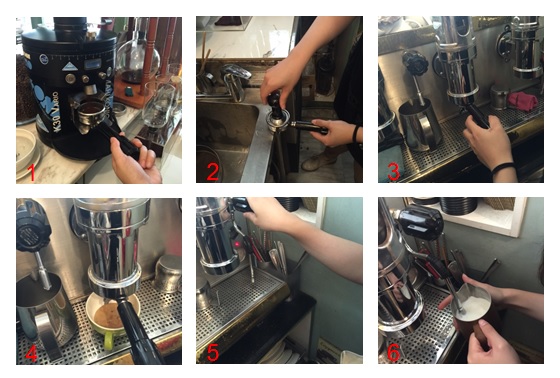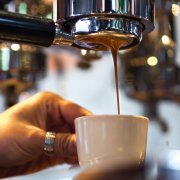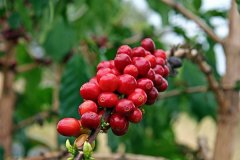[video teaching] ESPRESSO cooking method of espresso and the process of making jacquard lattes

Professional coffee knowledge exchange More coffee bean information Please pay attention to coffee workshop (Weixin Official Accounts cafe_style)
Espresso coffee extraction detailed steps Italian concentrated common sense
What is espresso?
In fact, it is an espresso coffee-based coffee drink, which includes latte, cappuccino, macchiato and combos. The origin of espresso comes from Italy. In Italy, espresso contains the meaning of express, which means that you should order the drink now and drink it immediately after espresso is made. You can't wait for others to drink it. After the espresso is made, there will be a "crema" on it, which must be drunk before the crema foam dissipates, otherwise it will lose its smooth taste, and gradually increase the sourness as it cools down with time, and an unbalanced salty taste will appear. Of course, some players like to wait until the espresso cools down before drinking, and drink the cold taste, because the tongue will have different taste sensitivity depending on the temperature.
Another important feature of espresso is extraction time. Espresso extracted by pressure can efficiently bring both water-soluble and fat-soluble substances into the cup, with an optimal average time of about 30 seconds, less than 15 seconds for weak and unbalanced sour coffee, and more than 30 seconds for prickly, bad-tasting coffee. Espresso is a coffee drink and method of making, not a specific coffee bean or blend of coffee beans, so don't think Italy has coffee beans, people usually use dark roasted coffee beans to make espresso coffee.
Another very important element of espresso that is very different from other brewing methods is pressure. In the early 20th century, in order to quickly provide guests with coffee in a short time, the method of increasing the pressure of brewing water was developed, that is, the water was filled in a sealed heating pot, and then the water was boiled. At this time, the pressure generated by the water vapor can accelerate the efficiency of coffee extraction, which is the same principle as the current mocha pot. However, this method has a disadvantage, that is, there is no way to extract coffee at the correct temperature (about 90 ° C water), resulting in boiling water scalding coffee powder, resulting in a bitter taste. Then another way to generate pressure was developed, which was to use the arm of the coffee bar master to create pressure, which led to the espresso with crema, and later added springs to provide more stable pressure than the arm. Up to now, most coffee machines use electric pumps to provide labor-saving and stable pressure to extract coffee.
So espresso has a quantitative meaning, espresso is a small amount of coffee extracted from ground roasted coffee beans by hot water at a certain time.
Some of the relevant parameters range as follows:
Ground coffee powder dosage: 6.5 ± 1.5g
Water temperature: 90 ± 5℃
Injection water pressure: 9 ± 2 bar
Extraction time: 30 ± 5 sec.
Coffee serving size: 15- 50ml, preferably 25- 30ml (depending on the personal preference of the consumer or coffee barman)
I hope this video helps you.
▼
LATTE ART Production Process
What is espresso?

(Fig. 1-4) Grinding, compaction and extraction
Prepare a steel cup to pour milk into the groove at the lower edge of the groove, in preparation for frothing before the first steam about 1-2 seconds (to spray the wet steam, and then frothing will be fine) will be inserted into the milk tube to the steel cup and milk surface at a 45 degree angle, steam first frothing milk, so that milk vortex form (do not hesitate to increase steam if the steam pressure is too low will not be formed) milk heated, the volume will expand and cover the nozzle, blocking the air. For more foam, lower the steel cup so that the nozzle stays on the surface of the milk. For less foam, raise the steel cup so that the milk covers the nozzle.
TIP: When milk is heated to about 60--65 degrees, it tastes sweet and can be drunk immediately. If you continue to heat the lactose in the milk, it will be destroyed and the taste will not be good!!!
(bottom)
Mix coffee and milk foam, shake to form preconceived pattern (onion heart leaf tulip etc. pattern)
Important Notice :
前街咖啡 FrontStreet Coffee has moved to new addredd:
FrontStreet Coffee Address: 315,Donghua East Road,GuangZhou
Tel:020 38364473
- Prev

What is the difference between coffee and espresso? How to make espresso coffee
Professional coffee knowledge exchange More coffee bean information Please pay attention to coffee workshop (Weixin Official Accounts cafe_style) Espresso coffee extraction detailed steps Italian espresso common sense Many people have such a question: coffee and espresso what is the difference? Although this question sounds silly, it does make sense when you think about it carefully. After all, some of them have just come into contact with coffee.
- Next

Which is better, single coffee or espresso? what do you recommend?
Professional barista communication Please follow the coffee workshop (Wechat official account cafe_style) how to choose coffee, choice beans or formula beans? Is it better to make coffee with beans or to serve beans alone? Generally speaking, coffee has a variety of charming charm, delicious and their own preferences have something to do with, so it is important to understand the characteristics of coffee. Single coffee is the most unique product of coffee beans.
Related
- Beginners will see the "Coffee pull flower" guide!
- What is the difference between ice blog purified milk and ordinary milk coffee?
- Why is the Philippines the largest producer of crops in Liberia?
- For coffee extraction, should the fine powder be retained?
- How does extracted espresso fill pressed powder? How much strength does it take to press the powder?
- How to make jasmine cold extract coffee? Is the jasmine + latte good?
- Will this little toy really make the coffee taste better? How does Lily Drip affect coffee extraction?
- Will the action of slapping the filter cup also affect coffee extraction?
- What's the difference between powder-to-water ratio and powder-to-liquid ratio?
- What is the Ethiopian local species? What does it have to do with Heirloom native species?

